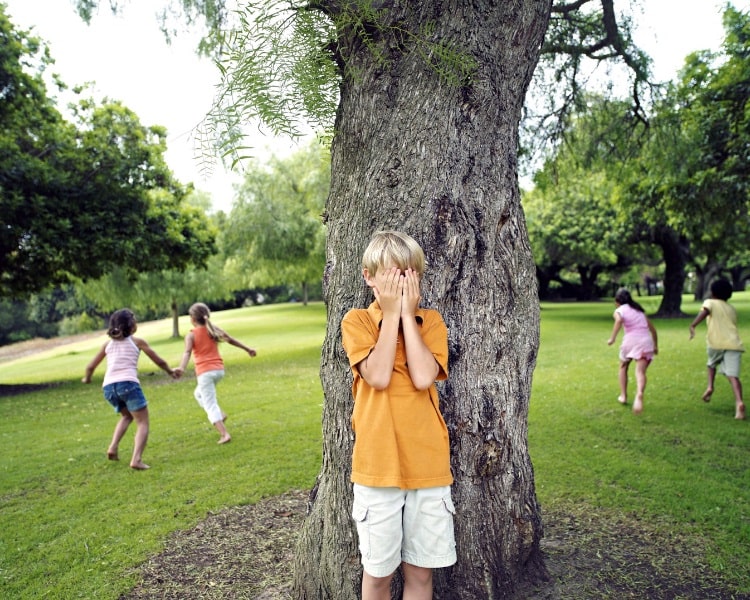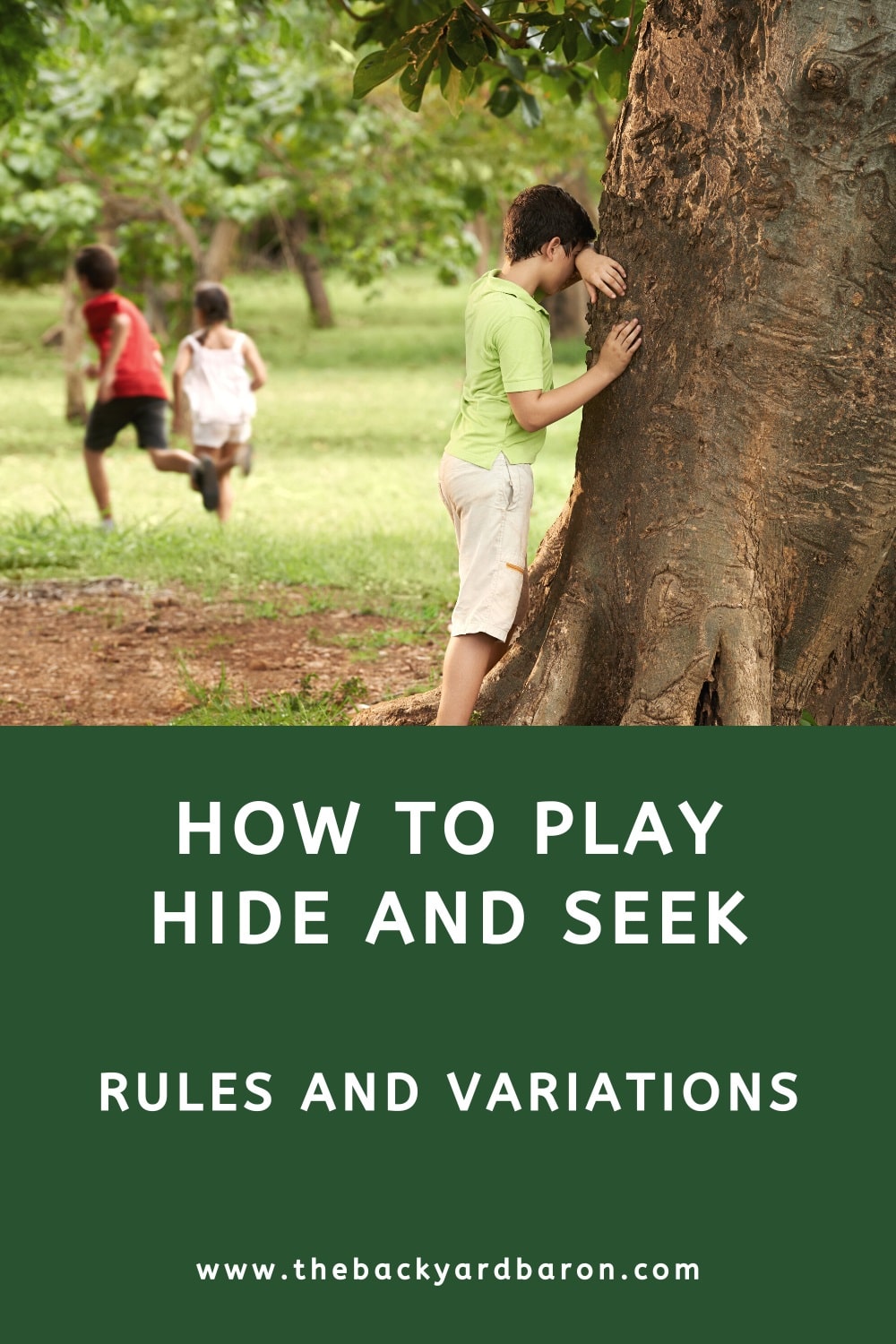Last updated: October 20, 2023
If you have a big enough backyard with trees, furniture pieces, and other objects and elements, hide and seek can be a great game to keep kids (and adults) entertained for a few hours.
While hide and seek is quite the basic game, there are some rules involved that you may not be aware of. Plus, there are also fun variations to make the game even more exciting.
In this article, I am going to walk you through how to play hide and seek, its rules, the variations, and the benefits of playing this fun game.
Quick navigation:
What Is Hide and Seek?
Hide and seek has roots dating back as far as the ancient Greeks, and has since been making a difference as a fun family game throughout the world.
The game goes by various names, depending on which country you’re in. Here are a few examples of international hide and seek names:
- Spain: el escondite, las escondidas
- France: jeu de cache-cache
- Israel: machboim
- South Korea: sumbaggoggil
- South/Central America: tuja, escondidas, cucumbè
As you probably already know, the concept of hide and seek is simple:
- Hide:
One player, or several players, have to be out of plain sight, making it as hard as possible to be found. - Seek:
One player has to find the player or players that are hiding in the surrounding area.
While this game is historically known as a kids game, adults can play it too and have just as much fun. It’s a real family game that can bring everyone together.
Now, let’s dive a little deeper into the actual rules of the hide-and-seek game.
Rules of Hide and Seek
There will need to be at least two players for a game of hide and seek to work. One player becomes “it”, the seeker, and their task is to find the other player(s) hiding. In this article, I refer to the players as the “seeker” and the “hiders”.
The seeker covers their eyes, often turning around against a wall or a tree. The seeker counts to an agreed number, which is usually 10. However, longer counts, such as up to 30, may be needed for larger areas.
The seeker counting must be loud enough for the people hiding to hear. At this point, the hiders are scrambling to find a good enough hiding spot.

Some areas can be declared off-limits if it’s too challenging or dangerous, keeping the game fair for everyone. For example, if you’re playing inside a home, you can say the basement or attic isn’t allowed if it’s too dark.
Once the seeker is finished counting, they must say something like, “Ready or not, here I come!”. It must be loud enough to let the hiders know they must stop moving around and stay hidden in their spot.
Hiders must pick a spot and stay there until they are found. Staying quiet is often the challenging part, especially when the seeker is close by, and there’s a bit of a thrill.
The seeker can turn into a real scavenger, looking for clues to find the hiders. Once the seeker has found all the hiders, the last player that was found, wins. The first player found becomes the seeker in the next game.
To recap, keep these rules in mind when playing hide and seek:
- Must have at least two players.
- Agree on a countdown to shout with the seeker’s eyes covered.
- Seeker tries to find the player(s) hiding.
- The first player found becomes the seeker in the next game.
- The last player found is the winner.
While these are the basics of hide and seek, there are other rules that you can add to make the game more exciting.
You can make these rules up, or you can consider a few official or unofficial variations that you can find online.
Hide and Seek Variations
Let’s go through a few popular variations of the hide-and-seek game.
1. Tag
Sometimes, the chase is better than the catch, and “Tag” is a fun way to mesh with hide and seek.
Players begin the game with the seeker loudly counting down. When the counting is over, the seeker has to find and catch the hiders. In the original game, it’s sufficient for the seeker to declare they’ve found someone, to point, or to be close to them.
However, in this Tag variant, the seeker now has to tag (touch) the people hiding after they’ve found them. The seeker does not win until they’ve caught the people hiding. This game can go on for much longer than anticipated, as the people hiding can continue seeking cover in different areas, despite having been found before in a different location.
The Tag version of hide and seek typically also burns a lot more energy and calories, which makes for a great workout.
2. Sardines
A popular variation of hide and seek is called Sardines, which is kind of the reverse of the game’s original concept.
Instead of one seeker trying to find everyone else hiding, in Sardines, only one player is hiding, and there are several seekers. When a seeker finds the player hiding, they have to join them in hiding.

As the game progresses, it becomes more challenging for the people hiding because there is increasingly less space available to hide, and the people hiding become like sardines in a tin can.
The last player seeking loses the game and becomes the hider in the next round of sardines.
3. Wave
This hide-and-seek variation begins just like the original version but becomes more complicated for the seeker once they find someone hiding.
After the seeker finds a player hiding, that player must follow the seeker in search of the others.
If that player finds another player hiding before the seeker does, they will wave, which releases the player hiding. From that point on, that player can start hiding again, picking a new spot.
4. Home Base
Home base is another popular hide-and-seek variation, and there are, in fact, several versions of it.
The main concept is to pick a spot that is called “home”. That spot is now a safe space for hiders. The seeker may keep an eye on it, but they must also actively seek for people hiding and prevent them from reaching the home base.
The hiders must make it to home base without being caught by the seeker to win the game. If the seeker sees the hider before they make it home, the hider loses.
There are no rules to what the home base can be, although something harder to defend, such as a tree (that is round and high), can make the game enjoyable.
Benefits of Playing Hide and Seek
There are several benefits to playing hide and seek for both children and adults.
1. Helps Develop Social Behaviors
In 2003, a study observed children aged 3 to 5 playing hide and seek and noted the children’s social and cognitive abilities.
The study indicated that hide and seek may help develop a child’s social behaviors because the game requires keeping a secret. The older the child, the higher their ability to keep a secret, highlighting the development of a child’s mental state in a social world.
2. Encourages Physical Exercise
Both children and adults need exercise, and playing hide and seek is a fun and exciting way to get that essential exercise in.

It’s also an effective way to teach children about being active at a young age to encourage better habits as they develop.
3. Boosts Creativity
Finding places to hide can boost children’s creativity as they assess their surroundings. Looking for a good spot to hide from others is a great way to stimulate their imagination and creativity skills.
4. Learn Sportsmanship
Learning the concept of good sportsmanship can help children not become too emotional after “losing”.
While there is not much wrong with being competitive, hide-and-seek is meant to be fun for everyone, and good sportsmanship is crucial.
5. Improves Problem-Solving Skills
Playing hide and seek encourages children to multi-task and find solutions. They must also look at things from different perspectives.
Evaluating hiding places to weigh the risks sounds complicated, but it’s an aspect that comes with playing hide and seek.
6. Quality Family Time
Sometimes, being an adult can be hectic, and unlocking your inner child can help bring back old memories, tapping into happiness.
Hide and seek is a fantastic game for the whole family, triggering relaxation and happiness.
Conclusion
As you can tell, hide and seek may be a basic game with simple rules, but with a few variations thrown into the mix, it’s a fun game for the whole family to enjoy.
The benefits are also evident, so why not invite some friends over and play a few rounds of hide and seek in the backyard right now!
Here are some more fun backyard games to try:
- Outdoor parachute games for kids.
- How to play marbles (rules and tips).
- How to play hopscotch (rules and variations).

